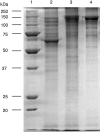Molecular and insecticidal characterization of a Cry1I protein toxic to insects of the families Noctuidae, Tortricidae, Plutellidae, and Chrysomelidae
- PMID: 16820473
- PMCID: PMC1489379
- DOI: 10.1128/AEM.02861-05
Molecular and insecticidal characterization of a Cry1I protein toxic to insects of the families Noctuidae, Tortricidae, Plutellidae, and Chrysomelidae
Abstract
The most notable characteristic of Bacillus thuringiensis is its ability to produce insecticidal proteins. More than 300 different proteins have been described with specific activity against insect species. We report the molecular and insecticidal characterization of a novel cry gene encoding a protein of the Cry1I group with toxic activity towards insects of the families Noctuidae, Tortricidae, Plutellidae, and Chrysomelidae. PCR analysis detected a DNA sequence with an open reading frame of 2.2 kb which encodes a protein with a molecular mass of 80.9 kDa. Trypsin digestion of this protein resulted in a fragment of ca. 60 kDa, typical of activated Cry1 proteins. The deduced sequence of the protein has homologies of 96.1% with Cry1Ia1, 92.8% with Cry1Ib1, and 89.6% with Cry1Ic1. According to the Cry protein classification criteria, this protein was named Cry1Ia7. The expression of the gene in Escherichia coli resulted in a protein that was water soluble and toxic to several insect species. The 50% lethal concentrations for larvae of Earias insulana, Lobesia botrana, Plutella xylostella, and Leptinotarsa decemlineata were 21.1, 8.6, 12.3, and 10.0 microg/ml, respectively. Binding assays with biotinylated toxins to E. insulana and L. botrana midgut membrane vesicles revealed that Cry1Ia7 does not share binding sites with Cry1Ab or Cry1Ac proteins, which are commonly present in B. thuringiensis-treated crops and commercial B. thuringiensis-based bioinsecticides. We discuss the potential of Cry1Ia7 as an active ingredient which can be used in combination with Cry1Ab or Cry1Ac in pest control and the management of resistance to B. thuringiensis toxins.
Figures





Similar articles
-
Potential of the Bacillus thuringiensis toxin reservoir for the control of Lobesia botrana (Lepidoptera: Tortricidae), a major pest of grape plants.Appl Environ Microbiol. 2007 Jan;73(1):337-40. doi: 10.1128/AEM.01511-06. Epub 2006 Nov 3. Appl Environ Microbiol. 2007. PMID: 17085712 Free PMC article.
-
Use of Bacillus thuringiensis toxins for control of the cotton pest Earias insulana (Boisd.) (Lepidoptera: Noctuidae).Appl Environ Microbiol. 2006 Jan;72(1):437-42. doi: 10.1128/AEM.72.1.437-442.2006. Appl Environ Microbiol. 2006. PMID: 16391075 Free PMC article.
-
Binary toxins from Bacillus thuringiensis active against the western corn rootworm, Diabrotica virgifera virgifera LeConte.Appl Environ Microbiol. 2004 Aug;70(8):4889-98. doi: 10.1128/AEM.70.8.4889-4898.2004. Appl Environ Microbiol. 2004. PMID: 15294828 Free PMC article.
-
Evolution of Bacillus thuringiensis Cry toxins insecticidal activity.Microb Biotechnol. 2013 Jan;6(1):17-26. doi: 10.1111/j.1751-7915.2012.00342.x. Epub 2012 Mar 29. Microb Biotechnol. 2013. PMID: 22463726 Free PMC article. Review.
-
Insecticidal crystal proteins of Bacillus thuringiensis.Microbiol Rev. 1989 Jun;53(2):242-55. doi: 10.1128/mr.53.2.242-255.1989. Microbiol Rev. 1989. PMID: 2666844 Free PMC article. Review.
Cited by
-
Identification of a New cry1I-Type Gene as a Candidate for Gene Pyramiding in Corn To Control Ostrinia Species Larvae.Appl Environ Microbiol. 2015 Jun;81(11):3699-705. doi: 10.1128/AEM.00379-15. Epub 2015 Mar 20. Appl Environ Microbiol. 2015. PMID: 25795679 Free PMC article.
-
Evaluation of cytotoxicity, genotoxicity and hematotoxicity of the recombinant spore-crystal complexes Cry1Ia, Cry10Aa and Cry1Ba6 from Bacillus thuringiensis in Swiss mice.Toxins (Basel). 2014 Sep 29;6(10):2872-85. doi: 10.3390/toxins6102872. Toxins (Basel). 2014. PMID: 25268978 Free PMC article.
-
Study of the Bacillus thuringiensis Cry1Ia Protein Oligomerization Promoted by Midgut Brush Border Membrane Vesicles of Lepidopteran and Coleopteran Insects, or Cultured Insect Cells.Toxins (Basel). 2020 Feb 21;12(2):133. doi: 10.3390/toxins12020133. Toxins (Basel). 2020. PMID: 32098045 Free PMC article.
-
Whole genome sequencing of a novel Bacillus thuringiensis isolated from Assam soil.BMC Microbiol. 2023 Mar 31;23(1):91. doi: 10.1186/s12866-023-02821-0. BMC Microbiol. 2023. PMID: 37003972 Free PMC article.
-
Generation of insect-resistant and glyphosate-tolerant rice by introduction of a T-DNA containing two Bt insecticidal genes and an EPSPS gene.J Zhejiang Univ Sci B. 2015 Oct;16(10):824-31. doi: 10.1631/jzus.B1500056. J Zhejiang Univ Sci B. 2015. PMID: 26465130 Free PMC article.
References
-
- Abdul-Rauf, M., and D. J. Ellar. 1999. Toxicity and receptor binding properties of a Bacillus thuringiensis CryIC toxin active against both Lepidoptera and Diptera. J. Invertebr. Pathol. 73:52-58. - PubMed
-
- Bradford, M. M. 1976. A rapid and sensitive method for the quantitation of microgram quantities of protein utilizing the principle of protein-dye binding. Anal. Biochem. 72:248-254. - PubMed
-
- Bradley, D., M. A. Harkey, M. K. Kim, K. D. Biever, and L. S. Bauer. 1995. The insecticidal CrylB crystal protein of Bacillus thuringiensis ssp thuringiensis has dual specificity to Coleopteran and Lepidopteran larvae. J. Invertebr. Pathol. 65:162-173. - PubMed
-
- Choi, S. K., B. S. Shin, E. M. Kong, H. M. Rho, and S. H. Park. 2000. Cloning of a new Bacillus thuringiensis Cry1I-type crystal protein. Curr. Microbiol. 41:65-69. - PubMed
Publication types
MeSH terms
Substances
Associated data
- Actions
LinkOut - more resources
Full Text Sources
Other Literature Sources

